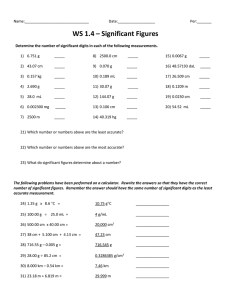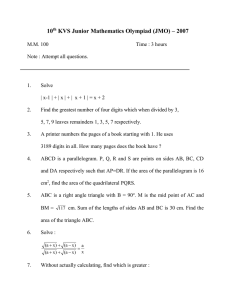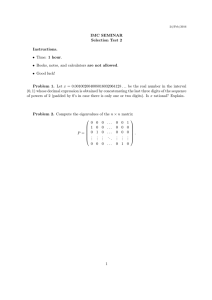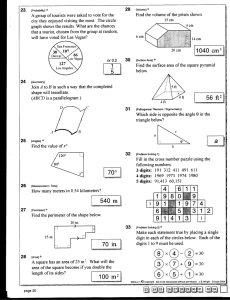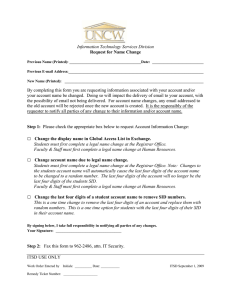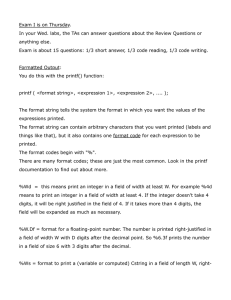KVJMO – 2007 SOLUTIONS CASE II :
advertisement
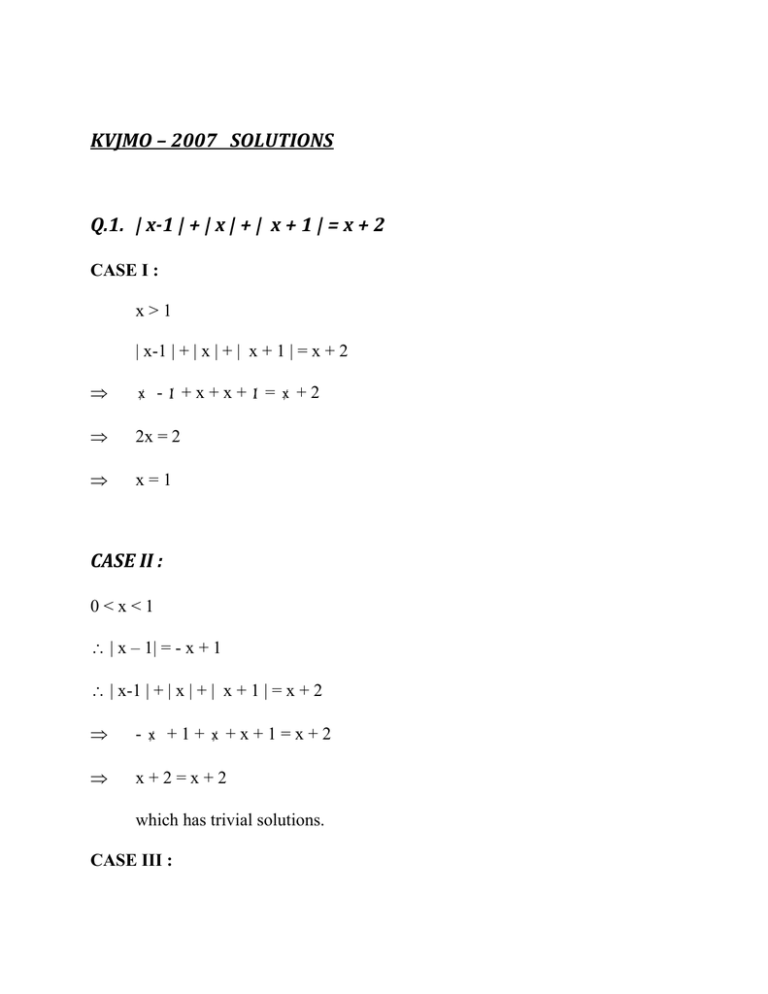
KVJMO – 2007 SOLUTIONS Q.1. | x-1 | + | x | + | x + 1 | = x + 2 CASE I : x>1 | x-1 | + | x | + | x + 1 | = x + 2 x - 1 + x + x + 1 = x + 2 2x = 2 x=1 CASE II : 0<x<1 | x – 1| = - x + 1 | x-1 | + | x | + | x + 1 | = x + 2 - x + 1 + x + x + 1 = x + 2 x+2=x+2 which has trivial solutions. CASE III : When, x < 0 |x–1|=-x+1 |x|=-x |x+1|=-x–1 | x-1 | + | x | + | x + 1 | = x + 2 - x + 1 - x - x - 1 = x + 2 - 3x = x + 2 - 3x – x = 2 - 4x = 2 x=-½ CASE IV : x=0 | x-1 | + | x | + | x + 1 | = x + 2 | 0-1 | + | 0 | + | 0 + 1 | = 0 + 2 | - 1| + 0 + |1| = 0 + 2 1+1=2 2=2 x = 0 also satisfies the equation x = 1 , 0, -½ are the solutions of the equation. Q2. First, L.C.M. of 3, 5, 7 and 9 = 315 Now, The largest four – digit number multiple of 315 = 315 x 31 = 9765 the required number which leaves remainders of 1, 3, 5, 7 [(3-2), (5-2), (7-2), (9-2)] on division by 3, 5, 7 and 9. Q3. = 9765 – 2 = 9763 First, The printer printed 9 single digits numbers (1-9), upto 9 i.e. 9 x 1 = 9 digits. No. of digits remaining to be printed = 3189 – 9 = 3180 Then, the printer printed 90 2 – digits numbers (10-99), upto 99 i.e. 2 x 90 = 180 digits. No. of digits remaining to be printed 3180 – 180 = 3000 digits. Then, the printer printed 900, 3 – digit numbers, (100 – 999) upto 999 i.e. 3 x 900 = 2700 digits. No. of digits remaining to be printed = 3000 – 2700 = 300 digits. Now, Only 300 more digits are left to be printed. No. of 4-digit numbers which can be printed using 300 digits 300 75 4 75 more numbers can be written after 999. i.e. (999 + 75) = 1074 The book has 1074 pages. Q4. D R C N S A Given : AP = DR ar (ABCD) = 16 cm2 ar (PQ RS) = ? Construction : Draw SMPR and QNPR Q P B Now, DC||AB DR||AP DR||AP and DR=AP APRD is a parallelogram ar (APRD) = (Base) x (Height) = PR x SM ar (SPR) = ½ x (Base) (Height) = ½ x PR x SM = ½ x ar (APRD) Also, DC = AB DR + RC = AP + PB RC = PB DC || AB RC || PB RC || PB and RC = PB RCBP is ar a parallelogram (RCBP) = (Base) x (Height) = PR x QN (i) (QPR) = ½ x (Base) x (Height) = ½ x PR x QN = ½ x ar (RCBP) Adding (i) and (ii), ar (SPR) + ar (QPR) = ½ x ar (APRD) + ½ x ar(RCBP) ar (PQRS) = ½ (ar (APRD) + ar (RCBP) = ½ x ar (ABCD) = ½ x 16 = 8 cm2 ar (PQRS) = 8 cm2 ….(ii) Q5. A M 117cm B C Given : ABC is right – angled at B. M is the mid – point of AC BM = 117 cm AB + BC = 30 cm ar (ABC) = ? Const : Draw the circumcirle of ABC Now, angles formed on the semi-circle are right angles. And ABC = 90o AC must be the diameter, M is the mid-point of AC. M is also the centre of the circle. Hence, AM = CM = BM = Radius AM = CM = BM = 117 cm AC = AM + CM = 117 + = 117 = In 2 117 ABC, B = 90o AC = 2 117 cm AB + BC = 30 cm By Pythagoras theorem, we have, AB2 + BC2 = AC2 (AB + BC)2 – 2.AB.BC = AC2 (30)2 – 2.AB.BC = (2 117 )2 900 – 2.AB.BC = 4 X 117 900 – 4 X 117 = 2.AB.BC 2.AB.BC = 900 – 468 AB.BC = 432 =216 cm2 2 ar (ABC) = 1 x (Base) x (Height) 2 = 1 x (AB) x (BC) 2 = 1 x 216 2 = 108 cm2 ar (ABC) = 108 cm2 Q6. (a x) (a x) a (a x) x (a x) a x 1= a=x CHECK : L.H.S. = (a a) (a a) (a a) (a a) 2a 0 = = R.H.S.= 2a 0 1 a a 1 x a L.H.S. = R.H.S Verified Q7. 3111 or 1714 31 < 32 or 31 < 25 or 3111 < (25)11 or 3111 < 255 17 > 16 or 17 > 24 or 1714 > (24)14 or 1714 > 256 3111 < 255 and 1714 > 256 and 256 > 255 1714 > 3111 Q8. a3 + b3 = c3 + d3 and a + b = c + d a3 + b3 = c3 + d3 (a+b) (a2-ab+b2) = (c+d) (c2 - cd + d2) a2 – ab + b2 = c2 – cd + d2 (a+b)2 – 3ab = (c + d)2 – 3cd -3ab = -3cd ab = cd ab = cd It does not satisfy the condition. So, it is not possible for a3 + b3 = c3 + d3 and a + b = c + d, Simultaneously ab cd 2 2 ab = cd Here, A.M. of a, b is equal to AM of c, d And G.M. of a, b is equal to G.M. of c, d This is only possible when a,b and c,d are equal But, they must be distinct It is not possible, if a and b are distinct. Q9. 312 + 2 12 – 2.66 = (36)2 + (26)2 – 2. (3 x 2)6 = (36)2 + (26)2 – 2. (36) x (2)6 = (36 – 26)2 = 3 = 3 3 2 3 23 2 2 23 33 23 2 = [(33+23) + (33-23)]2 = [(3+2) (32 - 3 x 2 + 22) (3-2) (32 + 3 x 2 + 22)]2 = [(5) x (9 - 6 + 4 ) (1) x (9 + 6 + 4)]2 = [(5) x (19) x (7)]2 = [5 x 19 x 7]2 = 52 x 192 x 72 The largest prime factor of (312 + 212 – 2.66) = Q10. 19 P Q By using the principle of Pascal’s triangle, we have, 1 1 1 1 2 1 3 2 1 3 6 4 10 10 20 There 1 4 are 20 paths possible from P to Q.
